Observing vs Photographing? Two completely different things
The differences between eye and camera, in an article that want to explain why some photographs don't express the same emotion of being there.
The functional differences between an eye and a camera are not many, but the difference between observing and photographing are much more pronounced. In this article we'll go into how the two differ, trying to not to write "medical", but "photographic". We'll give some technical information about the eyes, how we look (alternating movements and fixations) and stereoscopic vision and finally some useful explanations for training the photographer's eye and understanding why certain photographs fail to give the emotions we experienced when shooting.
I honestly believe that this is one of the most useful articles on our entire website. It's also often ignored in many other website, where the implications that this knowledge could have in photography are generally not described. Please read it carefully, because this article is the fruit of years of observation and summarizes many of the concepts I have learned since I have this passion.

Similarities between eye and camera
Anyone who has studied a minimum of photography and seen an episode of the cartoon Once Upon a Time... Life will have realized that the functioning of a camera is very similar to that of a human eye. To make it very simple, light passes through one lens and a hole, so that it can be projected onto a sensitive wall, impressing it. In reality, eyes and camera are much more complex than that. In cameras there are many lenses because they have to compensate for all the optical distortions, and also, in Reflex Cameras, there are prisms that converge the light into the eyepiece. In our case let's simplify as much as we can and think of a hypothetical camera, without a flash, schematized to be little more complex than the first camera obscuras that were used in the mid-19th century.
In the image below you can see how light passes through the lens elements in a camera , then is "restrained" by the diaphragm
which opens and closes to determine how much light should enter, then it is projected through "corrective" lenses onto the film
or sensor which, when impressed, returns an image of what was framed.
The eye works in much the same way, light passes through the cornea, then is restrained by the pupil, which opens and closes
to determine how much light should pass through, then it is projected onto the retina, which, via the optic nerve,
sends to the brain the information about what is being watched. In the image below you can see a simplified diagram of how the eye works
respect to a camera.
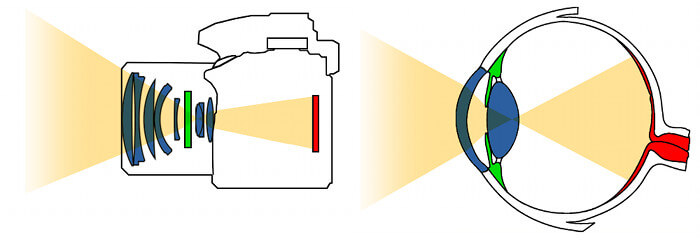
You can see, in Yellow, the light passing through the camera lens and cornea, in Blue the lens system, which in the eye is replaced largely by the lens, in Green the diaphragm and pupil and in Red the camera sensor, in the eye replaced by the retina. The more observant of you will have noticed that the image is always upside down. This is compensated by the camera's processor and brain, which process the frame to give us a straight image.
The biggest difference between the eye and the camera is that the camera moves a large number of fixed lenses to accomplish focusing, while in the eye there are muscles that deform the retina, so a single "lens" allows focusing at all distances. Of course, even here the reality is much more complex than the diagram above, in the eye there are structures, muscles, iris, veins, arteries and much more, but the basic operation is as described. In the image below you can see a realistic drawing of the camera and eye, with all the components of which they are composed of.
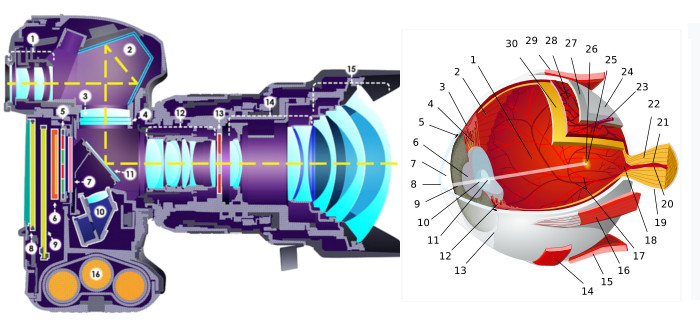
Eye technical specifications
Once we have clarified how it works, let's talk about the technical characteristics of the eye. This point is not very important, because the technical specifications of the eye are not so incredible. The magic happens in the brain, that can process it better than any digital video processor. Let's analyze them anyway, because it's curious:
- Sensor size: The retina is a hemisphere with a diameter of about 2.3 centimeters
- Resolution: The sensitive surface of the retina is divided between cones and rods, so there are about 6 million cones for central vision (color) and 120 million rods for peripheral vision (black and white)
- Focal Length: 17mm to 24mm, with a great loss of definition moving away from the center
- Focal Aperture: f/2.1 to f/8.3, with pupil dilation time of about 30 seconds
- ISO Sensitivity: 50 to 60,000 ISO, with a strong loss of color perception as sensitivity increases
- Shutter speed: From a minimum of 24 frames per second to get the illusion of motion to a maximum of 300 frames per second
- Color depth: The visible spectrum varies between 770 and 430 THz, roughly 10 million colors
So how much is the effective resolution of the eye? We'll go into more detail later, but a rough answer is: approximately 6 megapixels for a single glance and 570 megapixels during a full-field observation, moving the eyes and head, because eye movement is a fundamental part of viewing.
Differences between eye and camera
Once we know the technical data, a very important factor must be considered. The human eye is only an optical system. Most of
the vision processing is done by the brain, which uses eye movements to create an image like the one we are used to. Without getting
too technical, the extent of the visual field is about 140° horizontally and 120° vertically. Much of this field is handled by the rods,
which are "sensors" that specialize in seeing motion but are incapable of clearly recognizing shapes or colors. Once an object enters the
visual field, an instinctive movement of the head and the eyes takes over, allowing the point of interest to be seen by the part of the retina
that is specialized in clearly recognizing shapes and colors. This area is called the Fovea and covers a very narrow field of vision,
about 8° horizontally and 6° vertically.
To observe a scene, the eyes alternates between movements and fixations. When we observe, we focus on the points that most attract the brain's attention,
and the brain merge them into a complete image. In the example below you can see an animation I made to give a very indicative idea of human vision.
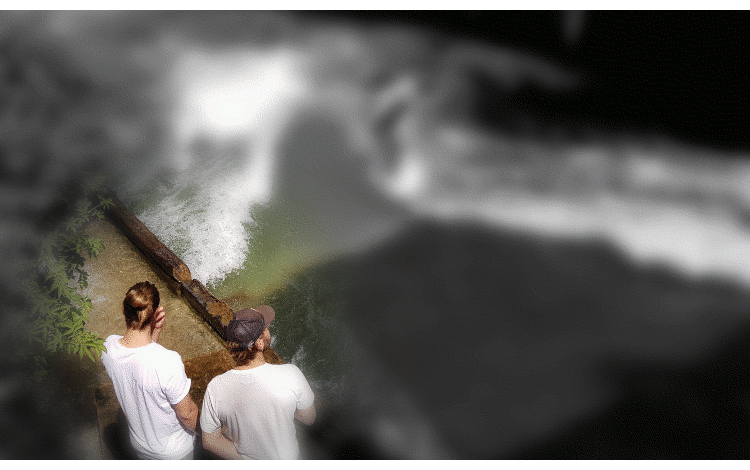
Usually the selection of fixation points is subjective and depends on personal experience, but it has been studied that in the case of specific demands the gaze focuses mainly on certain objective areas. In the image below (taken from Wikipedia) you can see the result of a study in which subjects were asked to observe a photograph for three minutes. The eye movement has been tracked. In the upper right image there's the free observation, lower left is when observer has been asked asked to memorize faces and in the lower right the observer has been asked to remember the position of objects and people in the room.
Viewing is thus not like a photograph, where the camera merely captures a scene, but is an active operation. During observation the brain, thanks to memory, is able to combine a very rapid series of "snapshots" into a coherent image, with far fewer limitations than a camera in terms of white balance and dynamic range. A camera that were to shoot a scene illuminated by mixed lighting (natural and artificial) will always have the colors tending to two different tones. The human brain, on the other hand, is able to automatically correct the white balance for every single "snapshot" it observes, and after it compose an image that is always correctly balanced.
Thanks to this ingenious expedient, it is also possible to have a very high dynamic range. If, for example, we take a photograph of a room with an
open window in the daytime, most likely the room will be dark or the window will be overexposed. The eye, on the other hand, takes a snapshot of the
window with the correct exposure, after which another snapshot of the room with the correct exposure and merges them into a single mental image
with the perfect exposure, as is the case, for example, in HDR photographs.
Of course, all these operations are unconscious and occur instinctively, but they allow us to understand how complex the simple fact of
looking at something. In the image below, we present two examples for white balance problems and reduced dynamic range.
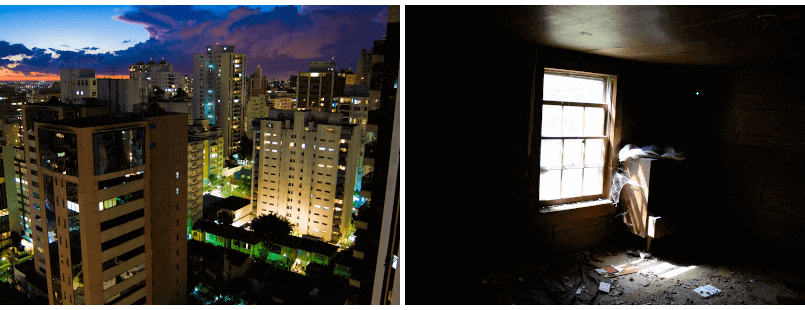
Stereoscopic vision
Everything discussed above refers to a single image, but there are two eyes and they are not limited to observing a single snapshot.
What we do, when we observe something, is not to take a snapshot, but rather to record a memory of what we are interested in.
Everything we observe has depth, has a subject and has a duration in time. In addition, the brain tends to associate emotions with that image and
what it perceives from the other senses. Observation is also conditioned by these elements.
Perspective is also something we need to consider in photography. The fact that we can observe with two eyes allows us to understand the distance of various objects from each other and to position them correctly in space. When we take a photograph we are projecting a three-dimensional space onto a two-dimensional image. If the photo lack clear perspective references, the viewer will not be able to reconstruct the distance of the various elements and everything will be blurred, as in the image below, whose perspective references have been removed.
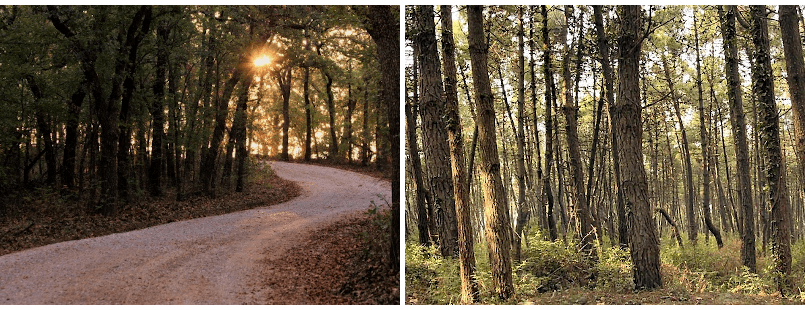
Another point to keep in mind is the brain's ability to eliminate distracting elements. If we are looking at something really interesting,
we are unlikely to notice the context where it's placed. If a beautiful car is parked in a parking lot full of litter, we will most likely
not even notice it. If we are focused on looking at a beautiful painting displayed in a gallery, we will not even be aware of the color of
the wall where it is hanged. This ability to focus on a single detail in photography doesn't exist. When we look at a picture, we look
at it as a whole.
The only solution is cropping, so we should use a tight composition to make the viewer look only at
what we are interested in, framing out distracting elements. This is where zooming comes to our aid, allowing us to frame only what our
eye would focus on. Some photo editing techniques can also be useful, such as vignetting. In the image below, crop and vignetting were used
to draw attention to the bird.

The last point to consider is the senses involved. If you think of a clear memory, as your first car, your partner, a family member, or anything
else. What comes to your mind? Definitely an image, but accompanied by a feeling that is related to the emotion that this memory carries.
In fact, the brain tends to store information not as slides, but as stories. The act of associating an emotion with a memory is the job of
the hippocampus, the part of the brain that is responsible for transferring information from short-term to long-term memory.
When we take a photograph, all the emotional part of the shot cannot be transferred to the viewer. The viewer of a photograph cannot know
what emotions the photographer was feeling when he took the picture, but he usually tends to imagine it through the association of what he
sees and his personal experiences. Stop for a second and think about this....
Why some photographs "doesn't work"
Let's try to summarize. Very often we tend to confuse observing with photographing. As I have tried to explain above, they are two radically different activities. Observing is an active operation, involving the subject with emotions and feelings. Photographing, on the contrary, is an operation that we do for other people, in that we have to portray something that will be observed. In the composition of a photo it is necessary to remember that the observer is not involved, so it should be our concern to frame in the shot all the components necessary to convey the emotions that the photograph want to evoke.
Of course, this is only necessary for photographs that have to be seen by other. In vacation photographs, the fact of having experienced the moment and being able to describe it, compensates for the shortcomings in terms of composition. When a professional takes a photograph, he makes sure that everything that is needed is framed at the right time, and everything that is not needed is skillfully ignored. This technique must be learned very well if you want to create truly effective photographs.
Remember to include elements in the shot that can give stimulation to the viewer's senses. If you are photographing an oriental market,
try to frame the spices, the colors, the people and put all this atmosphere into a photograph. If you are photographing New York City,
try to give the impression of the grandeur of the skyscrapers, the vitality, the traffic.
Try to train your eye to see how a certain scene will render in a photograph, closing one eye and framing it with your hand like
the almost caricatured directors you see in movies. Alternatively, always try to look through the camera's viewfinder; it will allow you
better understand how a shot will come out.
Don't forget about photo editing. If a scene conveys a particular mood, using color balances, adjusting the
contrast and the corrections that can be made in post production are definitely a great help. I will not elaborate here
my opinion on photo editing, but I believe that in order to be complete photographers, it is necessary to have the skills to correct the
flaws that our photographs inevitably might have.
The last piece of advice I can give you is not to get too attached to a poor photograph, only becasue it took a lot of effort to be
shot. The observer will never see the effort behind a photo, he will just observe whether he likes the photograph or not.
In all of this, we must not forget the greatest positive side of photography over reality, which is that it allows us to frame only what we are interested in, fooling the observer into believing that a breathtaking view was taken in total solitude, when perhaps we had to wait half an hour to wait for tourists to get out of the frame, as in the example image, where it is shown that the images we are used to seeing are not always realistic.
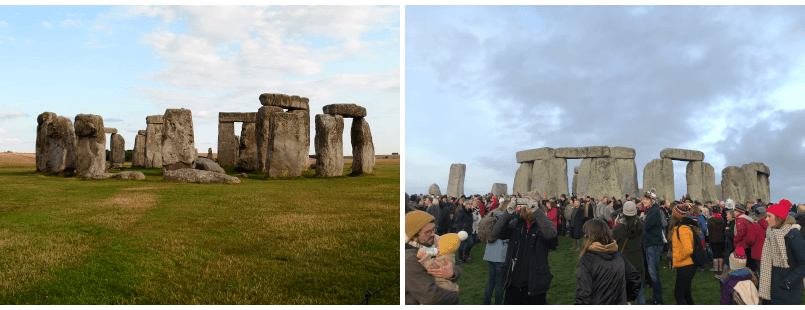
Many pictures used in this tutorial have been downloaded from Morguefile, an online archive of photos.
If you liked this tutorial here you can find all the other tutorials we wrote about photography, or you can go there to take a look to our tutorials for post production with Gimp. If you liked our work, you could consider to ❤support us: by clicking here you can see how.